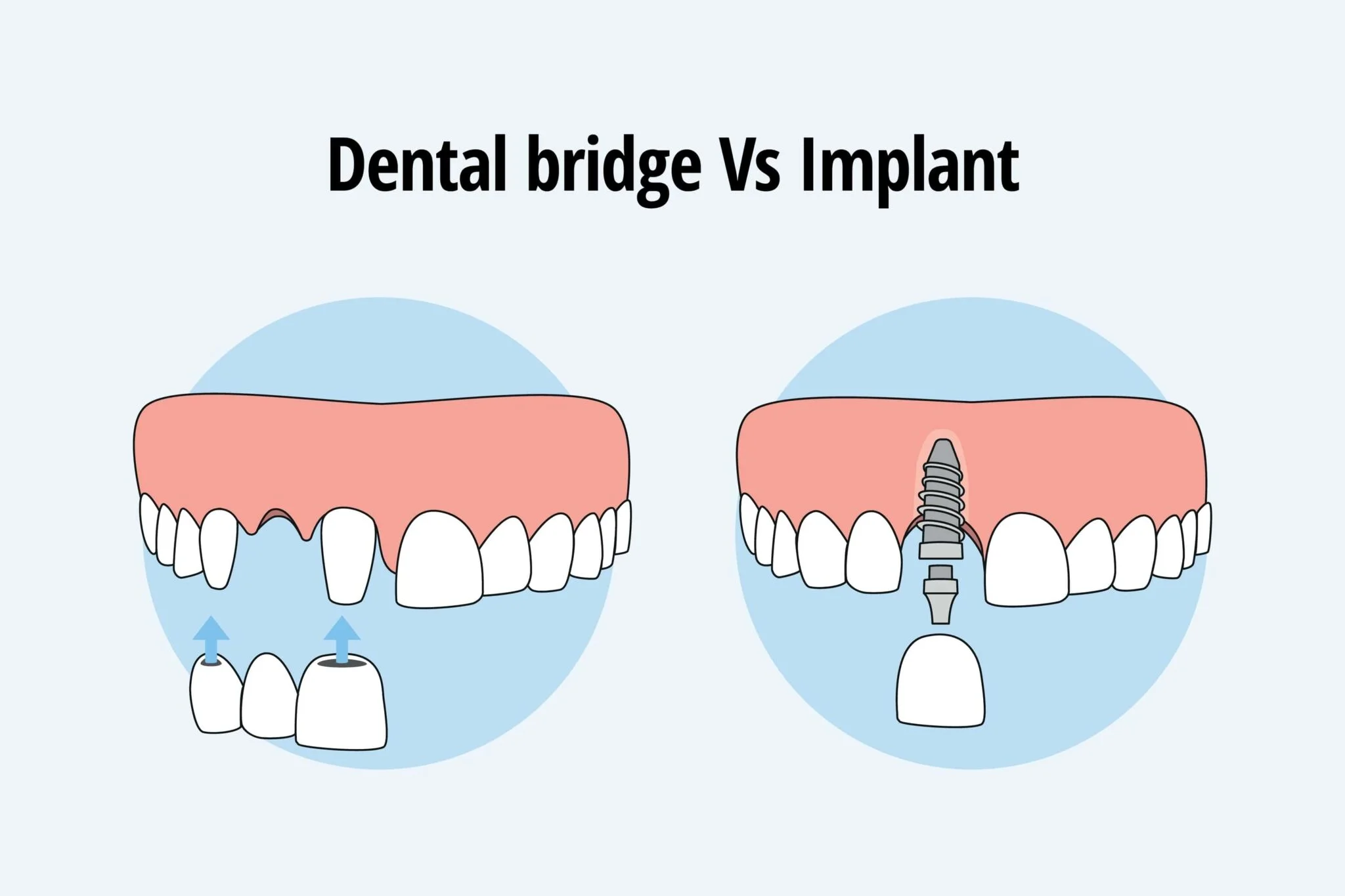Losing a front tooth can significantly impact an individual’s confidence, speech, and ability to chew, profoundly affecting daily life. Beyond the immediate aesthetic concerns, a missing front tooth can lead to more serious oral health issues, including bone loss in the jaw, shifting of adjacent teeth, and changes in facial structure over time. For those facing this challenge, the decision between a dental bridge vs dental implant for front missing tooth is paramount. Both options offer effective solutions for restoring your smile and oral function, yet they differ significantly in terms of procedure, longevity, impact on adjacent teeth, and cost. Understanding these distinctions is crucial for making an informed choice that aligns with your specific needs, health considerations, and financial plan. This comprehensive guide will meticulously examine dental implants and bridges, providing the authoritative insights necessary for patients, particularly those from the UK, contemplating treatment options both at home and abroad, such as in Turkey.
Table of Contents
Understanding Dental Implants for Front Teeth
A dental implant represents a sophisticated and durable solution for tooth replacement, particularly effective for the highly visible and functionally critical front teeth. Unlike traditional prosthetics, an implant is designed to mimic the entire tooth structure, from root to crown.
What is a Dental Implant?
A dental implant consists of a small, biocompatible titanium post surgically placed into the jawbone beneath the gum line. This post acts as an artificial tooth root, providing a stable foundation for a custom-made crown. Over time, the titanium post fuses with the jawbone through a process called osseointegration, creating a remarkably strong and permanent anchor. This integration is a key factor in the long-term success and stability of Dental Implants in Turkey or anywhere else.
Procedure Overview for Front Teeth
The process of receiving a dental implant typically involves several stages:
- Initial Consultation and Planning: A thorough examination, including X-rays and possibly 3D scans, is conducted to assess bone density, gum health, and overall oral condition. This stage determines if you are a suitable candidate and develops a precise treatment plan.
- Tooth Extraction (if necessary): If the damaged front tooth is still present, it will be carefully extracted. Adequate healing time is then allowed before implant placement.
- Bone Grafting (if required): For patients with insufficient jawbone density, a bone graft may be necessary to create a strong enough foundation for the implant. This adds several months to the overall treatment timeline.
- Implant Placement: The titanium post is surgically inserted into the jawbone. This procedure is performed under local anaesthesia, often with sedation, to ensure patient comfort. Following placement, a healing period of several months (typically 3-6) is required for osseointegration.
- Abutment Placement: Once the implant has fully integrated with the bone, a small connector piece called an abutment is attached to the implant post. This abutment will hold the final crown.
- Crown Placement: Impressions are taken to create a custom porcelain crown that matches the colour, shape, and size of your natural front teeth. This crown is then securely attached to the abutment, completing the restoration.
Advantages of Implants
Dental implants offer numerous benefits, especially for a front missing tooth. They are highly durable and long-lasting, often enduring for decades or even a lifetime with proper care. Critically, implants help to preserve jawbone health by stimulating the bone, preventing the bone loss that typically occurs when a tooth root is absent. This maintains facial structure and prevents the sunken appearance that can result from tooth loss. Implants also stand alone, meaning they do not require altering adjacent healthy teeth, a significant advantage over bridges. Aesthetically, they provide an extremely natural appearance and feel, making them virtually indistinguishable from natural teeth.
Disadvantages of Implants
Despite their many advantages, dental implants also have drawbacks. The most notable is the extended treatment timeline, which can span several months due to the osseointegration process and any necessary preparatory procedures like bone grafting. Implants typically involve a higher initial cost compared to bridges, although their long-term value often offsets this. There are also surgical risks associated with any invasive procedure, though complications are rare when performed by experienced professionals. Patients should also be aware of understanding dental implant discomfort, which is usually manageable but should be factored into recovery expectations.
Medical Research Integration
A systematic review and meta-analysis published in the Journal of Oral Implantology (2018, Vol. XLIV, No. 2, pp. 100-112) by Jung et al., investigating the long-term clinical outcomes of dental implants and fixed dental prostheses (bridges), revealed that dental implants demonstrate superior long-term survival rates and reduced biological complications compared to conventional fixed dental prostheses over a 10-year period. The study emphasized the importance of maintaining adequate bone volume for implant success and noted a higher incidence of secondary caries and endodontic issues in abutment teeth supporting bridges, highlighting implants as a more biologically conservative option in many cases.
Understanding Dental Bridges for Front Teeth
Dental bridges are another well-established method for replacing a missing front tooth, serving as a non-surgical alternative to implants. They literally ‘bridge’ the gap created by tooth loss.
What is a Dental Bridge?
A dental bridge is a prosthetic device consisting of one or more artificial teeth (pontics) held in place by dental crowns cemented onto the natural teeth adjacent to the gap. These adjacent teeth are called abutment teeth. The bridge effectively restores both the appearance and function of the missing tooth or teeth. To learn more, consider exploring Dental Bridges in Turkey and their various applications.
Types of Bridges
Several types of dental bridges are available, each suited for different situations:
- Traditional Bridges: This is the most common type, involving crowns placed on the abutment teeth on either side of the missing tooth, with the pontic suspended between them. This option requires significant alteration of the adjacent healthy teeth.
- Cantilever Bridges: Used when there is only one natural tooth adjacent to the missing tooth. The pontic is supported by a crown on only one abutment tooth. This is less common for front teeth due to forces on a single anchor.
- Maryland Bonded Bridges (Resin-Bonded Bridges): These bridges use metal or porcelain ‘wings’ bonded to the back of the adjacent teeth, rather than requiring full crowns. They are more conservative as they involve minimal tooth preparation, making them a viable option for front teeth where cosmetic concerns and tooth preservation are priorities.
Procedure Overview for Front Teeth
The process for a dental bridge typically involves two dental visits:
- First Visit – Tooth Preparation: The dentist prepares the abutment teeth by removing a portion of the enamel to make space for the crowns. Impressions of your teeth are then taken to send to a dental lab for custom fabrication of the bridge. A temporary bridge may be placed to protect the prepared teeth while the permanent one is being made.
- Second Visit – Bridge Placement: Once the permanent bridge is ready, it is checked for fit and aesthetics. Adjustments are made as necessary, and then the bridge is permanently cemented onto the prepared abutment teeth.
Advantages of Bridges
Dental bridges offer several compelling advantages. They typically have a shorter treatment timeline compared to implants, often completed within a few weeks. They can be a more cost-effective initial solution than implants, which can be an important consideration for many patients. Bridges effectively restore chewing function and speech, and when well-crafted, they provide a natural-looking restoration that blends with existing teeth. For individuals who are not candidates for implant surgery due to medical conditions or insufficient bone density, a bridge offers a viable alternative.
Disadvantages of Bridges
The primary disadvantage of traditional dental bridges is the requirement to alter healthy adjacent teeth. These teeth must be filed down to accommodate the crowns, which can weaken them and increase their susceptibility to decay or nerve damage in the future. Bridges also do not address bone loss in the area of the missing tooth, as there is no root stimulating the jawbone. This can lead to a sunken appearance over time. The average lifespan of a bridge is generally shorter than an implant, typically 5-15 years, meaning it may require replacement sooner. Maintaining oral hygiene can also be more challenging with a bridge, as food particles can become trapped under the pontic, necessitating careful cleaning.
Dental Bridge vs Dental Implant for Front Missing Tooth: A Detailed Comparison
When considering dental bridge vs dental implant for front missing tooth, a direct comparison across various factors illuminates why one option might be preferable to another. This section provides a clear, authoritative overview to guide your decision-making process.
Longevity and Durability
Dental implants are renowned for their exceptional longevity, with many lasting a lifetime with proper care. Their integration into the jawbone provides unparalleled stability and durability. Dental bridges, while durable, typically have a shorter lifespan, often requiring replacement after 5-15 years. The longevity of a bridge is often limited by the health of the abutment teeth, which are more prone to issues.
Impact on Adjacent Teeth
One of the most significant differences lies in the impact on adjacent teeth. An implant is a standalone restoration, meaning it does not affect the neighbouring healthy teeth. In contrast, a traditional dental bridge requires the reduction of adjacent teeth to serve as anchors for the crowns, a procedure that is irreversible and can potentially compromise the long-term health of these otherwise healthy teeth. Maryland bridges offer a more conservative approach, but their bonding strength can be less robust.
Aesthetics and Natural Appearance
Both options can provide excellent aesthetic results, particularly for a front missing tooth. Dental implants often offer a superior aesthetic outcome because they emerge naturally from the gum line, just like a natural tooth. They also prevent bone recession, maintaining the natural contour of the gum and face. Dental bridges can also look very natural, but over time, if bone loss occurs beneath the pontic, a visible gap can form between the gum and the bridge, potentially affecting aesthetics and requiring revision.
Maintenance and Oral Hygiene
Maintaining oral hygiene with dental implants is similar to caring for natural teeth: regular brushing, flossing, and dental check-ups are key. Flossing around an implant is straightforward. For dental bridges, maintaining hygiene can be more challenging. Special floss threaders or interdental brushes are often required to clean underneath the pontic and around the abutment teeth to prevent plaque buildup and decay, which can jeopardize the bridge’s integrity.
Cost Considerations
The initial cost of a dental implant is generally higher than that of a dental bridge. However, when considering the potential need for bridge replacement over time and the possible costs associated with treating issues in abutment teeth, the long-term cost-effectiveness of an implant can be superior. Investing in an implant often represents a single, lasting solution. For a detailed breakdown, please refer to our price comparison table below, focusing on the UK versus Turkey.
Bone Health and Preservation
This is a critical distinction for a missing front tooth. The titanium post of a dental implant acts as an artificial tooth root, stimulating the jawbone and preventing bone loss (resorption) that naturally occurs after tooth extraction. This preserves the structural integrity of the jaw. A dental bridge, however, does not stimulate the bone beneath the missing tooth. Over time, this lack of stimulation leads to bone loss, which can affect the aesthetics of the gum line and potentially compromise the stability of neighbouring teeth.
Treatment Timeline
Dental implants typically require a longer overall treatment period, often spanning several months due to the surgical placement and the osseointegration process. Any necessary bone grafting can further extend this timeline. Dental bridges usually involve a much shorter treatment period, often completed within a few weeks from initial preparation to final cementation.
| Factor | Dental Implant | Dental Bridge | Maryland Bridge (if applicable) |
|---|---|---|---|
| Impact on Adjacent Teeth | None; preserves healthy teeth | Requires reduction of adjacent teeth | Minimal preparation; conservative |
| Bone Health | Preserves jawbone; prevents bone loss | Does not prevent bone loss | Does not prevent bone loss |
| Longevity | 20+ years, often lifetime | 5-15 years | 5-10 years |
| Aesthetics | Excellent; natural gum line | Good; potential for gum recession over time | Good; metal wings can be visible |
| Treatment Time | Several months (includes healing) | Weeks (2-3 appointments) | Weeks (2-3 appointments) |
| Maintenance | Like natural teeth (brush, floss) | Requires special cleaning tools (floss threaders) | Like natural teeth (brush, floss around wings) |
Factors Influencing Your Choice
Selecting the ideal front tooth replacement option—a dental bridge vs dental implant for front missing tooth—requires a careful evaluation of several personal and clinical factors. Your unique circumstances will heavily influence the most appropriate and successful treatment path.
Jawbone Health
Adequate jawbone density and volume are fundamental for the successful placement of a dental implant. If the jawbone has deteriorated due to prolonged tooth loss or other factors, a bone graft may be necessary, which adds complexity and time to the procedure. Patients with severe bone loss who are unwilling or unable to undergo bone grafting may find a dental bridge a more feasible solution. A thorough diagnostic assessment, including advanced imaging, is crucial to determine bone health.
Overall Oral Health
Your general oral health plays a critical role. For dental implants, healthy gums and sufficient supporting bone are essential. Active gum disease (periodontitis) must be treated before implant placement, as it can compromise implant success. For dental bridges, the health and structural integrity of the adjacent teeth are paramount, as these teeth will bear the load of the bridge. If the abutment teeth are compromised by decay, large fillings, or structural weakness, a bridge may not be a suitable long-term solution.
Budget and Insurance
Financial considerations are often a primary concern for patients, especially those from the UK where dental costs can be substantial. As previously noted, dental implants typically involve a higher upfront investment. However, considering the long-term benefits and reduced need for replacement, they can prove more cost-effective over decades. Dental bridges, while initially less expensive, may incur additional costs for replacements or treatment of abutment tooth complications over their lifetime. It is important to discuss payment plans, financing options, and what your dental insurance might cover for each procedure. Many international patients find that the overall cost savings in locations like Turkey make otherwise unaffordable treatments accessible.
Personal Preferences and Priorities
Your personal priorities regarding aesthetics, longevity, treatment duration, and invasiveness are key. If you prioritize a solution that feels and functions most like a natural tooth, prevents bone loss, and offers the highest long-term success rate without impacting adjacent teeth, an implant may be the preferred choice. If a quicker, less invasive procedure with a lower initial cost is more important, and you are comfortable with the maintenance and potential future replacement of a bridge, then a dental bridge might be more suitable. Your lifestyle, dietary habits, and commitment to oral hygiene should also factor into this decision.
The Procedure in Turkey: Why CK Health Turkey?
For patients from the UK contemplating a dental bridge vs dental implant for front missing tooth, Turkey has emerged as a leading destination for high-quality, affordable dental care. CK Health Turkey stands at the forefront of this movement, offering international patients exceptional medical services.
High Standards and Experienced Professionals
CK Health Turkey collaborates with state-of-the-art dental clinics equipped with advanced technology and staffed by highly qualified, internationally trained dentists and oral surgeons. These professionals possess extensive experience in complex dental procedures, including advanced implantology and aesthetic bridge placements for front teeth. Our clinics adhere to stringent international hygiene and safety standards, ensuring patient well-being and optimal outcomes.
Cost-Effectiveness
One of the most compelling reasons for UK patients to choose CK Health Turkey is the significant cost savings without compromising on quality. The lower operational costs in Turkey allow us to offer world-class dental treatments at a fraction of the price found in the UK. This affordability makes advanced procedures like dental implants, which might otherwise be financially prohibitive, accessible to a wider range of patients, enabling them to achieve their desired smile. This includes not just the procedure itself but often encompasses comprehensive packages.
Patient-Centric Approach
At CK Health Turkey, we understand that undergoing dental treatment abroad can be a significant decision. Our patient-centric approach ensures a seamless and comfortable experience from your initial inquiry to post-treatment follow-up. We provide comprehensive support, including assistance with travel arrangements, accommodation, and translation services. Our team is dedicated to clear communication, ensuring you are fully informed and confident at every stage of your dental journey.
Embark on Your Journey to a Restored Smile
Choosing between a dental bridge and a dental implant is a pivotal decision for your oral health and aesthetic appeal. CK Health Turkey offers transparent consultations, allowing you to discuss your options with leading dental specialists. We empower you to make an informed choice with confidence. Contact CK Health Turkey today to schedule your personalized consultation and discover how we can help you achieve a brilliant, healthy smile with world-class dental care.
Price Comparison: Dental Treatments in Turkey vs. UK
| Service/Item | Turkey Price (GBP) | UK Price (GBP) |
|---|---|---|
| Single Dental Implant (Post, Abutment, Crown) | £800 – £1,500 | £2,000 – £3,500 |
| 3-Unit Dental Bridge (per unit) | £200 – £400 | £500 – £1,000 |
| Bone Grafting (per site) | £300 – £600 | £800 – £1,500 |
| Comprehensive Consultation & X-rays | £50 – £100 | £150 – £300 |
| Full Arch Implant Restoration | £5,000 – £9,000 | £15,000 – £25,000 |
FAQs
What is the main difference between a dental implant and a dental bridge for a front tooth?
The main difference is that an implant replaces the entire tooth structure, including the root, by surgically placing a titanium post into the jawbone. A bridge, on the other hand, replaces only the visible part of the tooth by crowning adjacent healthy teeth and suspending an artificial tooth between them.
How long do dental implants typically last?
With proper care and oral hygiene, dental implants can last 20 years, often a lifetime. Their long-term success is largely due to their integration with the jawbone.
How long do dental bridges typically last?
Dental bridges generally last between 5 and 15 years. Their lifespan can be influenced by the health of the abutment teeth and the patient’s oral hygiene habits.
Is the dental implant procedure painful?
Local anaesthesia is used during implant surgery, so you should not feel pain during the procedure itself. Some discomfort and swelling are common during the recovery period, which can be managed with prescribed pain medication. Understanding and managing post-operative pain is crucial for a smooth recovery.
Will a dental bridge affect my other teeth?
Yes, a traditional dental bridge requires the adjacent healthy teeth to be prepared (filed down) to accommodate the crowns that support the bridge. This can potentially weaken these teeth and make them more susceptible to decay or sensitivity.
Can I get a dental implant if I have bone loss?
It depends on the extent of the bone loss. If there is insufficient bone, a bone grafting procedure may be performed first to build up the necessary bone volume. After a healing period, the implant can then be placed.
Which option is more aesthetically pleasing for a front tooth?
Both can offer excellent aesthetics. However, dental implants often provide a more natural look because they emerge from the gum line like a natural tooth and help preserve the underlying bone, maintaining facial contours over time.
Why is dental treatment in Turkey more affordable than in the UK?
Dental treatment in Turkey is often more affordable due to lower operating costs, including labour, materials, and facility expenses, without compromising on the quality of care or the technology used. This allows clinics like CK Health Turkey to offer competitive pricing to international patients.
What factors should I consider when choosing between an implant and a bridge?
Key factors include your overall oral health, jawbone density, budget, desired longevity of the restoration, impact on adjacent teeth, and your personal preference for treatment duration and invasiveness. A consultation with a dental professional is essential to weigh these factors.



